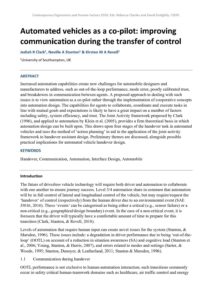| Document | Author Jediah R Clark, Neville A Stanton & Kirsten M A Revell |
| Abstract Increased automation capabilities create new challenges for automobile designers and manufacturers to address, such as out-of-the-loop performance, mode error, poorly calibrated trust, and breakdowns in communication between agents. A proposed approach to dealing with such issues is to view automation as a co-pilot rather through the implementation of cooperative concepts into automation design. The capabilities for agents to collaborate, coordinate and execute tasks in line with mutual goals and expectations is likely to have a great impact on a number of factors including safety, system efficiency, and trust. The Joint Activity framework proposed by Clark (1996), and applied to automation by Klein et al. (2005), provides a firm theoretical basis in which automation design can be built upon. This draws upon four stages of the handover task in automated vehicles and uses the method of ‘action planning’ to aid in the application of the joint activity framework to handover assistant design. Preliminary themes are discussed, alongside possible practical implications for automated vehicle handover design. |

